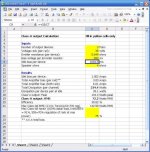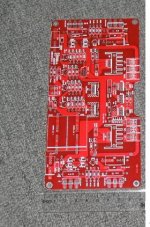Re: Recreating past audio experiences
That sounds to me as if the older amps were better.
Jozua said:Nico & others
.... But when it comes to meatyness, soundstage and the recreation of three dimensional depth the older pure class A Krells are still in a class of their own.
That sounds to me as if the older amps were better.
K-amps said:Troy... if you were in Indy... i'd let u use my "facilities" man...
Wish you the best.
Thank you.
"Last" (hopefully) court date was Monday. Sad day but the divorce should be final now (financial side, relationship side has been done). Judge stipulated the ex could NOT bring me to court for ANYTHING other than child issues ever again. Nobody wins a divorce, but I did get what I consider a favorable judgment.
I hope to start home shopping (great time as houses are relatively cheap right now!) early next year.
KSA 50 mkII @100W vs KSA 100 mkII
Hello to all of you,
I'm wondering which clone I'm going to build :
- KSA 50 MKII tweaked for 100 watts
- or KSA 100 mkII.
Through different threads I found several comparisons but no specific one for KSA 50 mkII @100W vs KSA 100 mkII.
Would you share on this and help me choose ?
Regards
Hello to all of you,
I'm wondering which clone I'm going to build :
- KSA 50 MKII tweaked for 100 watts
- or KSA 100 mkII.
Through different threads I found several comparisons but no specific one for KSA 50 mkII @100W vs KSA 100 mkII.
Would you share on this and help me choose ?
Regards
I have serial number 126 of the KSA 100 which used the same schematic as the original KSA 50 shown in this thread and it used 4 pairs of the Motorola outputs ( before Krell went to their own matched output devices and labeled them A and AA -possibly a commissioned run of matched outputs ) the original amps used all Motorola front end and outputs -though they went to Japanese input devices not much later ).Original build components were Dale brown body RN resistors, silver mica caps, bias bypass cap was a 0.1/100v polyester, Frako German electrolytics on the board, Mallory 37,500UF 75V were the main electrolytics, Tiffany RCA's, the main transformers were Western Signal EI core which possibly may have had an electrostatic shield unloaded DC voltage was 49 VDC and with the 2.5 amp bias on the output was 46 VDC - it has ground lead seperate from the AC input set - before Asian marketing demands made them go to torroids. I cascoded the input pair, added a DC servo, and regulated the front end, bypassed the main electrolytics with Wondercaps -all the other POOGE sufferings it went through etc etc
Hey all, quickie question...It appears to me that my Krell Clone has some "room" in the heatsink department. Three pairs of 2SA1943/2SC5200.
If I were to increase the bias to reach a heatsink temp of, say 55C, what would the safe limit be on the output devices, or any of the other components on the board?
I am currently measuring 40 - 45C on the sinks, and the dissipation per device at idle is just under 40 watts...am I near the safe limits on the output devices?
My stats are below...
Thanks!
If I were to increase the bias to reach a heatsink temp of, say 55C, what would the safe limit be on the output devices, or any of the other components on the board?
I am currently measuring 40 - 45C on the sinks, and the dissipation per device at idle is just under 40 watts...am I near the safe limits on the output devices?
My stats are below...
Thanks!
Attachments
I am running 4 ohm speakers...
I was wondering if it was worth while pushing the bias a little further as long as I had room in the heatsinks......
I have a few more 2SA1943/2SC5200, so I could add another pair to each side...I would have to look for the resistors tho....
I was wondering if it was worth while pushing the bias a little further as long as I had room in the heatsinks......
I have a few more 2SA1943/2SC5200, so I could add another pair to each side...I would have to look for the resistors tho....
Hello
Eve I sold the amplifier stuffed PC board I decided I still build these amp .
I purchased a pair PC board form Ebay , I think they are great design .
Separate power supply for the input ,The power transistors will be mounted in the PC board directly .
I ordered the PC board , for the input I use regulated power supply .
It only uses two pair out put transistors like the original KSA -50 use the . Like BOSOZ power supp .+/-50V for the input .
I found some rugged transistors so I can bias in a full Class A .
For the main power transformer I use 2x30V AC transformer from Plitron .
Resistor I pick Dale like the original
The power trans use MJL4302A / MJL4281A . These transistors has a great hfE .
Any comment welcome .
I f some one has a Krell badge I would be interested on a par since I gave as a gift to the guy who purchased my stuffed Krell PC boards .
I post a picture from the PC board I will use .
I found is a great advantage id the power transistors goes direct to the PC boards , don't need to use wire to wire them up .
Greetings
Eve I sold the amplifier stuffed PC board I decided I still build these amp .
I purchased a pair PC board form Ebay , I think they are great design .
Separate power supply for the input ,The power transistors will be mounted in the PC board directly .
I ordered the PC board , for the input I use regulated power supply .
It only uses two pair out put transistors like the original KSA -50 use the . Like BOSOZ power supp .+/-50V for the input .
I found some rugged transistors so I can bias in a full Class A .
For the main power transformer I use 2x30V AC transformer from Plitron .
Resistor I pick Dale like the original
The power trans use MJL4302A / MJL4281A . These transistors has a great hfE .
Any comment welcome .
I f some one has a Krell badge I would be interested on a par since I gave as a gift to the guy who purchased my stuffed Krell PC boards .
I post a picture from the PC board I will use .
I found is a great advantage id the power transistors goes direct to the PC boards , don't need to use wire to wire them up .
Greetings
Attachments
Don't forget there are still boards from the GB available. $28 per pair donated to DIYAudio plus $4.60US\$11 Global Priority mail. In fact, until 12/31 or the 12 pairs remaining are gone if you email me a PayPal receipt for a new donation of $30 or more to DIYAudio I will send you 2 boards for free anywhere I can send them for $11 through USPS. Keep the money where it will do some good!
Bob G.
Bob G.
Hello
I like these board better than from the group buy .
I already stated for me better if the power transistors goes direct to the PC board
The separate power supply to the fromt annd the back I think is a great idea .
Thirdly I already paid for the boards .
So I have to stick with them .
Greetings
I like these board better than from the group buy .
I already stated for me better if the power transistors goes direct to the PC board
The separate power supply to the fromt annd the back I think is a great idea .
Thirdly I already paid for the boards .
So I have to stick with them .
Greetings
john65b said:I am running 4 ohm speakers...
I was wondering if it was worth while pushing the bias a little further as long as I had room in the heatsinks......
I have a few more 2SA1943/2SC5200, so I could add another pair to each side...I would have to look for the resistors tho....
It might be a sonic trade-off..... from a reliability standpoint, adding another pair ought to do it.... but the more pairs you have the more they need matching...
Technically both are feasible, it would depend if you can make out the sound of the extra biasing/heat... personal choice.
Some of the nicest sounding amps have 1 pair in the output.... said to reduce smear
True, But Pass is selling amps that he will repair at his expense for 20+ years.
He's often said that for DIY use you can push it a bit harder if you are willing to live with potentially shorter parts life. He's also using mosfets that hard, bipolars may not be so forgiving at elevated die temperatures. Will this be a 20 year amp or replaced in the next few?
Run through the die temp calculation and see how much room you have. Most outputs can handle 150 C die temps, For commercial products NP keeps it down to 100 C. Remember that SOA is reduced at elevated temperatures. Aluminum oxide or Kapton isolators have lower thermal resistance than mca or silpads so you can run more power on the same heat sinks with them.
He's often said that for DIY use you can push it a bit harder if you are willing to live with potentially shorter parts life. He's also using mosfets that hard, bipolars may not be so forgiving at elevated die temperatures. Will this be a 20 year amp or replaced in the next few?
Run through the die temp calculation and see how much room you have. Most outputs can handle 150 C die temps, For commercial products NP keeps it down to 100 C. Remember that SOA is reduced at elevated temperatures. Aluminum oxide or Kapton isolators have lower thermal resistance than mca or silpads so you can run more power on the same heat sinks with them.
- Home
- Amplifiers
- Solid State
- Krell KSA 50 PCB


